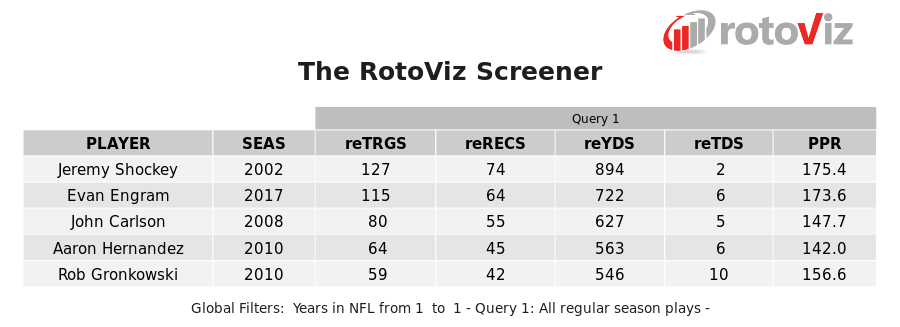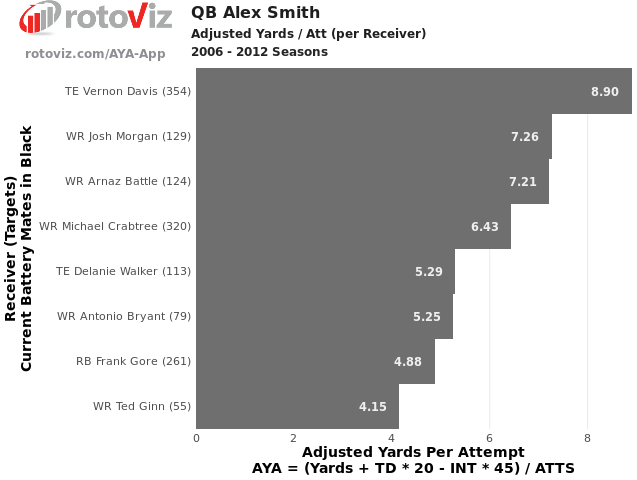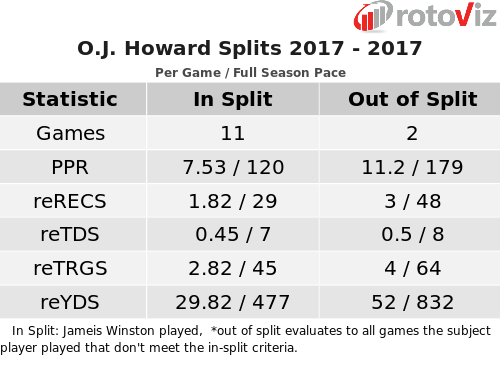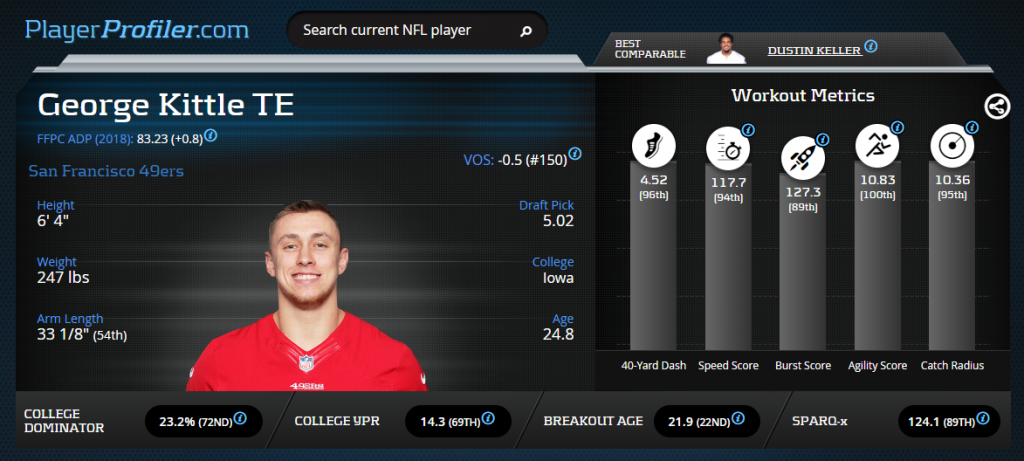Following our recent look at the AFC teams’ tight end picture, here is the complete breakdown for the NFC. This article will, like its predecessor, focus on the advanced stats, metrics, and analytics of the tight end position for each of the 16 NFC teams.
Dallas Cowboys
The Dallas Cowboys have been blessed for the past 15 seasons with Jason Witten at tight end. Witten will be in the commentary booth for the 2018 season, leaving the only team he ever played for to pick up the pieces left by his departure. The Cowboys approach to replacing Witten suggests they hope to get by with a committee of sorts. The members are Blake Jarwin, Geoff Swaim and 2018 draft pick Dalton Schultz. None of these players’ body of work suggest they are capable of emulating Witten. Jarwin’s College Dominator Rating of 7.1-percent was good for a spot in the ninth percentile. Swaim’s 4.9-percent? The sixth. By comparison, Schultz looks like a target monster with his 11.4-percent Dominator. That may not matter, however.
The Cowboys are one of the least pass-happy teams in the NFL. In fact, since the start of the 2014 season, no team has attempted fewer passes than the Cowboys. There is no doubt they are hoping this trio can block, in order to bolster their ground game with Ezekiel Elliott. This should explain why Rico Gathers spent his offseason bulking up to improve his blocking. This hasn’t worked. It will shock very few people when the Cowboys and Gathers part ways prior to the 2018 season.
New York Giants
Evan Engram‘s performance as a rookie was one of the few bright spots of the New York Giants 2017 season. Engram was not highly thought of as a blocker coming into the NFL, which is a key skill needed at the tight end spot, of course. Fortunately, due to a spate of injuries among the Giants’ pass catchers and the team’s reluctance to run, it wasn’t an issue. Since the dawn of the 21st century, only one rookie tight end has had more receptions and receiving yards than Engram.
Engram is comfortably among the top three pass-catching options on the Giants’ roster heading into 2018, maybe even the top two. But the Giants’ moves this offseason suggest they will be more committed to running the ball this season. This will certainly impact Engram’s workload, along with that of his teammates Odell Beckham and Sterling Shepard.
Philadelphia Eagles
Zach Ertz performed like one of the top tight ends in the NFL in 2018. He finished with a third consecutive 800-yard receiving season, as well as a career-high eight touchdowns. The Eagles waved goodbye to longtime stalwart Brent Celek following their Super Bowl LII victory; then, Trey Burton left in free agency. Ertz may pick up some of the slack left by their departures, but the Eagles didn’t want to leave it all to him. They brought in former Packer, Richard Rodgers, which, in the words of Shania Twain, “don’t impress me much.” They then spent a second-round draft pick on Dallas Goedert. Goedert was insanely productive at South Dakota and his closest comp on PlayerProfiler is Tyler Eifert.
While this move would seem to be one born of redundancy, the Eagles used two tight ends on offense more than all but four other teams in 2017. They also peppered this position with 24-percent of their total team targets. Goedert will need Ertz to have an injury to earn a primary role in the offense. But if 2017 and Burton are anything to go by, he will certainly be involved. Burton was able to perform quite nicely in spot duty when Ertz missed time last season.
Washington
If you’re going to bring in Alex Smith as your quarterback, it makes sense to have viable receiving options at your tight end spots. On paper, Washington has this with Jordan Reed and Vernon Davis. Reed has shown he can be a dynamic playmaker in the NFL but is rarely fully healthy. His 2017 season lasted a sub-par six games. But even during this truncated campaign, Reed remained a player the offense would try to go through. His 15-percent Hog Rate ranked No. 4 among NFL tight ends, but his 6.0 yards per target ranked No. 33.
Davis and Smith are old friends, having played together for the 49ers from 2006 to 2012. Indeed, the partnership Smith enjoyed with Davis was his most productive during this span, from an Adjusted Yards per Attempt standpoint.
Smith and the Kansas City Chiefs looked to their tight end on 32-percent of their total team targets last season. Washington, with Kirk Cousins at quarterback, looked their way 24-percent of the time. The Washington wide receiver corps is something of a question mark, outside of Jamison Crowder, at present. Paul Richardson and Josh Doctson have produced very little to mark them as outstanding and efficient players. This uncertainty may force Smith to look to his tight end. Which one is on the field, however, is another matter.
Chicago Bears
The Chicago Bears spent the last two years ensuring the tight end renaissance does not pass them by completely. They drafted Adam Shaheen out of tiny Ashland college in 2017, spending the 13th pick in the second round on him. Shaheen was dominant at Ashland, albeit at a lower level of competition, posting a 95th-percentile College Dominator rating of 36.4-percent. He saw only 14 targets in his rookie season, five of which came in the end zone. This is too small a number to have qualified for our rankings, but it equated to a 71.4-percent share of the teams end zone looks.
The Bears then signed former Eagles role player Trey Burton to a lucrative four-year deal. The Bears new head coach is Matt Nagy, a former offensive coordinator under Andy Reid and a coaching colleague of Doug Pederson. Burton is expected to fill the Travis Kelce role for the Bears, despite significant differences between the two. Burton is 6-3 and 235 pounds, while Kelce is 6-5 and 260. While Burton may see the majority of tight end targets, the high leverage scoring targets may fall to Shaheen.
Detroit Lions
Eric Ebron was released by the Lions at the end of the 2017 season. He is now coexisting with Jack Doyle on the Indianapolis Colts. The two men at the top of the tight end depth chart in Detroit are Luke Willson and Michael Roberts. Willson is one of the most athletic tight ends in the NFL. His 117.0 Speed Score puts him in the 94th-percentile, but his opportunities have been limited, especially after sitting behind Jimmy Graham in Seattle. Willson’s 39-percent snap share in 2017 was 69th among tight ends – far from good.
https://www.youtube.com/watch?v=ICKLAeVJnxc
Roberts is an unremarkable athlete, “boasting” a 4.86 40-yard dash and 107.5 Burst Score. He was dominant in college at Toledo, with a 73rd-percentile College Dominator rating. His senior season in 2016 saw him score 16 touchdowns on just 45 receptions. Many may not consider the Lions fertile ground to pluck tight end roses; but, for all his failings, Ebron was the TE15 in PPR formats between 2014 and 2017. He managed this feat whilst scoring only 11 touchdowns, too.
Green Bay Packers
Tight end is a spot the Packers have been applying Band-Aids to ever since they lost Jermichael Finley. Since the 2013 season, they have suffered through Andrew Quarless, Richard Rodgers, Jared Cook, Martellus Bennett and Lance Kendricks. Jimmy Graham is the latest square peg the team will try to jam into a round hole. Graham led all tight ends with 10 touchdowns last season but finished ninth in receptions and 17th in receiving yards.
https://www.youtube.com/watch?v=fDDcY3FYje8
It is evident that the late stage Graham is not about separation. His 1.29 yards of separation was 29th among tight ends. However, he is still capable of going up and fighting for the ball, with the highest Contested Catch Rate among tight ends (77-percent). Graham offers a red zone threat the Packers will need now that Jordy Nelson is in Oakland. But outside of the scoring area, he is not likely to provide too much.
Minnesota Vikings
Kyle Rudolph saw his role contract in 2017, with his Hog Rate falling from 13.6-percent in 2016 to 9.3-percent last season. But he was still among the most efficient and productive tight ends in the league. 14 of his 57 receptions came inside the red zone. Rudolph also scored eight touchdowns, one more than his tally in 2016. Kirk Cousins has shown an ability to forge profitable partnerships with tight ends. During the last three seasons in Washington, Cousins had 9.05 and 8.72 Adjusted Yards per Attempt when targeting Vernon Davis and Jordan Reed.
With the Vikings lacking a third wide receiver of any real consequence, Rudolph should remain heavily involved, and a key red-zone weapon. This will come in handy for Cousins. He attempted the seventh-most passes inside the red zone in the last three seasons, with 239. But his touchdown rate of 22.17-percent is the fourth lowest among the 14 quarterbacks with at least 200 attempts.
Atlanta Falcons
Austin Hooper is entering his third season in the NFL. After two seasons, a break out does not seem to be imminent. More than 16-percent of his career receiving yards came in a single game: Week 1 of the 2017 season. He was far and away the most active of the Falcons’ tight ends, playing on 80.2-percent of their offensive snaps. Hooper is able to generate yards after the catch, with the sixth most among tight ends last season (265). He also catches an awful lot of the balls sent his way, with only three players bettering his 75.4-percent catch rate.
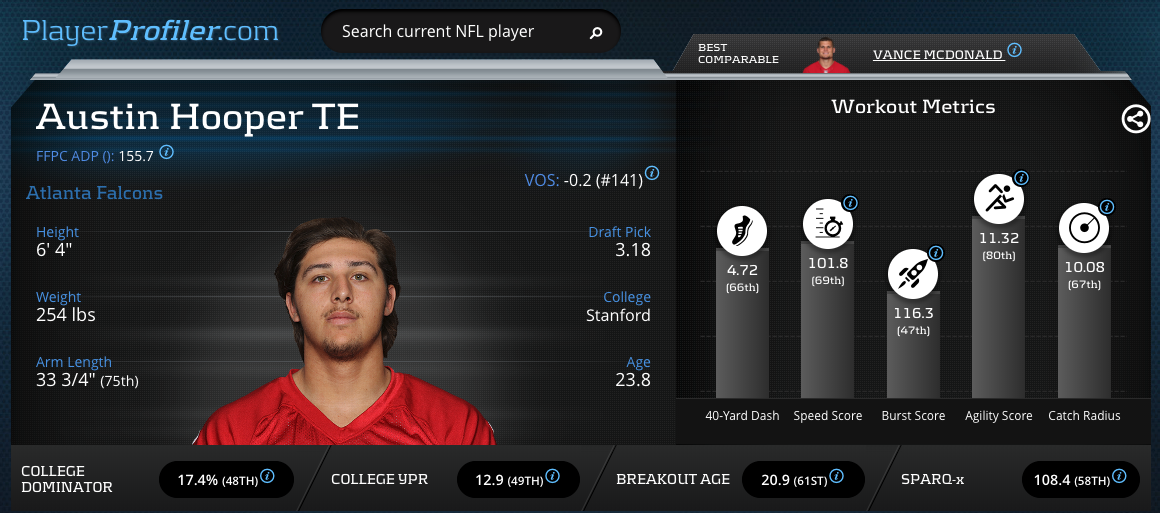
Austin Hooper Advanced Stats & Metrics Profile
Still, the Falcons targeted their tight ends on only 15-percent of their passing plays last season. The Falcons have Julio Jones, Mohamed Sanu and Calvin Ridley, plus two more-than-adequate pass-catching backs in Devonta Freeman and Tevin Coleman. It would surprise no one if all of these players contributed more to the Falcons passing game than Hooper in 2018.
Carolina Panthers
The 2017 season brought an end to a wildly productive streak for Greg Olsen. He is the only tight end in NFL history with three consecutive 1000-yard receiving seasons. Olsen returned after his injury in 2017 and remained a heavily targeted part of the passing game, but his effectiveness was not up to his usual standard. He saw 19.8-percent of the Panthers’ targets while on the field, the eighth highest among tight ends. However, he averaged only 2.4 receptions per game and averaged a pitiful 1.2 yards after the catch. Olsen signed a new two-year deal this offseason, tying him in for 2018 at least, but the Panthers have one eye on the time after Olsen.
https://www.youtube.com/watch?v=V8Q9eiVTot8
The Panthers spent a fourth round draft pick on the raw but exciting Ian Thomas this spring. He could take some red zone work away from Olsen, given his 85th-percentile arm length and 83rd-percentile catch radius. But Olsen, fitness permitting, will see the majority of the Panthers’ tight end snaps and targets. New offensive coordinator Norv Turner is, of course, a tight end guru when he is surrounded by Hall of Fame level talent at the spot. That could well include Olsen.
New Orleans Saints
During the Drew Brees era in New Orleans, the team has been among the league leaders in targeting tight ends. Indeed, between 2006 and 2016 the Saints targeted their tight ends 1,544 times, the third most of all NFL teams. This bias was not evident during 2017. They looked their tight end’s way on just 12-percent of their passing plays. Rather than embrace the tight end renaissance, the Saints have instead gone back to the past this offseason.
Ben Watson enjoyed a career season last time he was in a Saints uniform. The 2015 season brought him 74 receptions for 825 yards and six touchdowns. Watson was also near the top of many key performance metrics for tight ends last season with the Ravens. He was eighth in receptions with 61, and fifth in Target Premium with +19.0 percent. But as a playmaker, his numbers looked every bit those of a player who turned 37 towards the end of the season. He was 30th in Air Yards and 24th in Yards per Pass Route. With only Josh Hill to keep Watson company on the roster, it appears the Saints are content to let the tight end renaissance go on without them.
Tampa Bay Buccaneers
The Tampa Bay Buccaneers are like the Cleveland Browns – they have multiple skins in the game when it comes to the tight end renaissance. They have Cameron Brate, who posted the seventh-highest Hog Rate among tight ends last season with 13.7-percent, as well as the 12th-most fantasy points per game (8.9). Despite less than stellar workout metrics, Brate was in the top 10 in terms of separation with a 1.60 average per target.
The Buccaneers also drafted O.J. Howard in the first round in 2017. While lightly used, seeing only 39 targets, Howard was one of the most efficient playmakers of all tight ends. He led all tight ends in Air Yards, Target Premium, yards per target and fantasy points per route among others. Howard’s usage remains a question mark heading into 2018, given the presence of Mike Evans and DeSean Jackson along with Brate. Howard could start the season hot, especially if Ryan Fitzpatrick starts in the absence of Jameis Winston. It’s a small sample size, but Howard was a lot more productive when Winston was out of the lineup in 2017.
Arizona Cardinals
Tight end was not a position highly valued by Bruce Arians during his time with the Cardinals. Given new offensive coordinator Mike McCoy’s track record, it could be more of the same. When he has not had a Hall of Fame-level player like Antonio Gates, McCoy has not gotten much out of his tight ends. Only Jacob Tamme, with the Broncos in 2012, has seen at least 10-percent of a McCoy-led team’s target share.
Jermaine Gresham may not be 100-percent by the time the season comes around, leaving Ricky Seals-Jones atop the depth chart. RSJ is a player expected to break out this season after semi-emerging as a big part of the Cardinals offense in 2017. RSJ posted a 21.5-percent Hog Rate while finishing 11th in Dominator Rating with 20.7-percent. Sam Bradford has shown a willingness to use tight ends in the past, averaging 7.57 Adjusted Yards per Attempt when targeting Kyle Rudolph with the Vikings, but it’s anyone’s guess as to how many games Bradford will play.
San Francisco 49ers
George Kittle is a lot of peoples’ favorite break out candidate at tight end this season. This is probably due to the high regard people hold Jimmy Garoppolo and Kyle Shanahan in. It is also due to the form Kittle displayed as a rookie. He finished seventh in yards after the catch (260) and yards per target (8.2). Kittle was also a factor in the red zone for the 49ers. He reeled in nine of his 16 targets inside the opposition’s 20-yard line. Kittle is an athletic freak, finishing in at least the 89th-percentile in all five of the key PlayerProfiler workout metrics.
The 49ers also have Garrett Celek, a player Ollie Connolly wrote of in glowing terms recently. However, in three games Kittle played without Celek last season, his usage did not change much. Celek and Kittle saw a similar snap share last season, and there is a danger the two could cap each other’s production in 2018.
Seattle Seahawks
The Seahawks offense is not an area with any real degree of optimism. This is especially true of the tight end spot. Nick Vannett may need a change of scenery before he is able to truly break out, which I suggested earlier this offseason. Ed Dickson filled in manfully for Greg Olsen last season but was far from a superstar. Dickson finished 10th among tight ends with 245 Air Yards, but 19th in receiving yards. His fantasy points came in at only 5.7 per game. Dickson is also 31 years old. The Seahawks spent a fourth round draft pick on Will Dissly this year. Dissly played two seasons at tight end in college and posted a 20th-percentile College Dominator rating of 10.3-percent. Tight end is just another area of this offense that people should probably steer clear of in the short term.
Los Angeles Rams
The Los Angeles Rams offense was one of the best things about the entire 2017 season. It is truly upsetting they did so much good while using the tight end so little. They targeted their tight end on 17-percent of their pass attempts. According to Sharp Football stats, the Rams lined up in 11 personnel (with a single tight end) on a league-high 81-percent of plays in 2017. The Rams trotted out Tyler Higbee on 76.1-percent of their snaps. Higbee responded with a 6.8-percent Hog Rate (35th among tight ends).
https://www.youtube.com/watch?v=2O_h1wW3a3k
This snap share is particularly egregious. With the Rams primarily using a single tight end, it meant a meager 33.4-percent share for Gerald Everett. As well as being an athletic freak, Everett was dominant in college. His 31.7-percent College Dominator Rating is good for the 90th-percentile. The Rams success last season means they are unlikely to radically change their philosophy in 2018. Hopefully, Everett can push past the plodding Higbee on the Rams depth chart.

